Facility-Level Excess Mortality of VHA Patients With Mental Health or Substance Use Disorder Diagnoses
Abstract
Objective:
Individuals with mental or substance use disorders have higher mortality rates than people in the general population. How excess mortality varies across health care facilities is unknown. The authors sought to investigate facility-level mortality rates among Veterans Health Administration (VHA) patients who had received diagnoses of mental or substance use disorders.
Methods:
An electronic medical records–based retrospective cohort study was conducted, encompassing 8,812,373 unique users of 139 VHA facilities from 2011 to 2016. Covariates included age, sex, and past-year diagnoses of serious mental illness, posttraumatic stress disorder, major depressive disorder, other mental health conditions, or substance use disorders. The outcome was all-cause mortality per comprehensive Veterans Affairs/Department of Defense searches of the National Death Index. Proportional hazards regression was used to calculate overall and facility-specific hazard ratios (HRs) for each diagnosis group, adjusted for age, sex, and comorbid medical conditions.
Results:
Overall, all-cause mortality was statistically significantly elevated among VHA users with mental health diagnoses (HR=1.21, 95% confidence interval=1.20–1.22). HRs varied across facilities consistently over time. At the VHA facility level, diagnostic groups were significantly correlated with the degree of excess mortality. Results were similar in sensitivity analyses that excluded deaths from suicide or drug or alcohol overdose.
Conclusions:
VHA users with mental or substance use disorder diagnoses had elevated mortality rates. Correlation in excess mortality across two periods indicated that facility differences in excess mortality were persistent and therefore potentially associated with facility- and community-level factors, which may help inform quality improvement efforts to reduce mortality rates.



